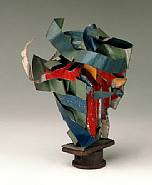Tony Cragg uses recycled materials to create his sculptures. For example, one takes the shape of a British flag, but up close there are colorful and individual shapes that are made from things like toothbrushes and metal washers, all painted. Other sculptures include reclaimed wood furniture.
'Stack', 1975
Look at all that trash! This cube is made out of completely recycled materials. I don’t know if this is held together with some type of trash glue, or if it is all held by stacking. The part that amazes me most is the circular barrel in the bottom right; it defies the cube aspect of the piece.
I couldn’t find a title for this piece, but my favorite part about this is the colors that he has used in making this piece. Each individual piece has its own individual colors that I am sure were different before they were painted to have continuity in the piece. The way it goes from violet to blue and contrasts with the orange and yellows is a great way to show this artists pallet. An artist’s pallet can consist of not only paint, but any kind of material. And the transformation that Cragg does proves that concept perfectly.
I do believe he painted each piece individually in this sculpture. All of these recycled materials have made this rainbow. There is no hidden pictures within but I think the hidden picture of needing to recycle and be green is the idea that is shown through this piece that he has created.
This is the flag that I was talking about in the introduction! This British flag is important to him because he is from Liverpool. He has made extremely precise lines with the random objects that he has chosen. I, however, do not like the spaces that are in between each section; I want it to feel more complete instead of all of that white space within those shapes.
Buttons! Why not create an art piece out of all of the buttons you have found. I think this is brilliant and beautiful. Using recycled pieces is cheap, and green; Cragg’s work really inspires me to use something else for my art work.

























